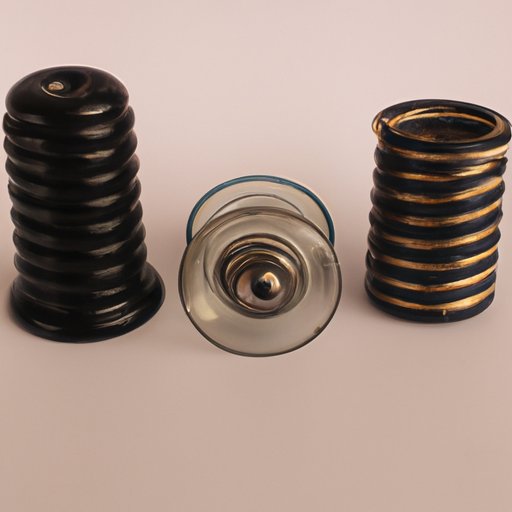Introduction
An insulator is a material that does not readily conduct electricity or heat. Insulators have many applications in science and engineering, such as in electrical wiring, insulation for buildings, and refrigeration systems. They are also used to protect people from electric shock and to reduce energy loss. In this article, we will explore what an insulator is, its properties, examples, and uses in science and everyday life.
Explaining Insulators in Science: Properties, Examples, and Uses
Insulators are materials that do not allow the transfer of heat or electricity. They are typically composed of non-conducting substances such as glass, ceramics, rubber, and plastics. Insulators are used in a variety of applications, including electrical wiring, insulation for buildings, and refrigeration systems. Let’s take a closer look at the physical properties of insulators, examples of common insulators, and their uses in everyday life.
Physical Properties of Insulators
Insulators have several characteristics that make them useful in science and engineering. These include the ability to resist the flow of electricity, low thermal conductivity, high dielectric strength, and high insulation resistance. Additionally, insulators are usually lightweight and durable, making them easy to install and maintain.
Examples of Common Insulators
Common examples of insulators include glass, plastic, rubber, ceramic, and wood. Glass is one of the most widely used insulators because it is inexpensive, strong, and relatively transparent. Plastic is another common insulator because it has a wide range of properties, including flexibility, durability, and chemical resistance. Rubber is often used as an insulator due to its elasticity, while ceramic is often used for its high temperature resistance. Finally, wood is a good insulator because it is a natural material that is able to absorb and retain heat.
Uses of Insulators in Everyday Life
Insulators are used in a variety of ways in everyday life. For example, they are used in electrical wiring to prevent electrical shocks and to reduce energy loss. Insulators are also used in construction to provide insulation from the outside environment. Additionally, insulators are used in heating, cooling, and refrigeration systems to keep the air or other fluids inside the system at a constant temperature.
Understanding Insulators in Science: How Do They Work?
Insulators work by preventing the flow of electricity or heat through them. This is accomplished by trapping electrons in the material so that they cannot move freely. The electrons in the material become trapped in “holes” in the structure and are unable to move. As a result, the material is unable to conduct electricity or heat.
In addition, insulators are able to block the transfer of heat or electricity by creating an air gap between two surfaces. This air gap acts as a barrier that prevents the transfer of heat or electricity. By creating an air gap, insulators can effectively reduce the amount of energy that is transferred between two surfaces.
A Guide to Insulators in Science: What Are Their Benefits?
Insulators are beneficial in a variety of ways. First, they are able to reduce energy loss in electrical wiring and insulation for buildings. Additionally, insulators can help protect people from electric shock by blocking the transfer of electricity. Finally, insulators are able to keep air or other fluids at a constant temperature in heating, cooling, and refrigeration systems.
Advantages of Using Insulators
Insulators have several advantages over traditional materials. First, they are typically lightweight and durable, which makes them easier to install and maintain. Additionally, insulators are able to block the transfer of heat or electricity, which reduces energy loss. Finally, insulators are able to keep air or other fluids at a constant temperature, which is beneficial in heating, cooling, and refrigeration systems.
Common Applications of Insulators
Insulators are used in a variety of applications, including electrical wiring, insulation for buildings, and refrigeration systems. They are also used in construction to provide insulation from the outside environment. Additionally, insulators are used in heating, cooling, and refrigeration systems to keep the air or other fluids inside the system at a constant temperature.
The Basics of Insulators in Science: Types and Applications
Insulators are classified according to their properties and application. Generally, there are three main types of insulators: electrical, thermal, and acoustic. Electrical insulators are materials that do not conduct electricity, while thermal insulators are materials that do not conduct heat. Acoustic insulators are materials that reduce the transmission of sound.
Classification of Insulators
Insulators can be further classified into different categories based on their properties and application. Examples of these categories include rigid insulators, flexible insulators, and thermal insulators. Rigid insulators are usually made of hard materials such as glass or ceramic, while flexible insulators are usually made of softer materials such as rubber or plastic. Thermal insulators are materials that have low thermal conductivity, meaning they do not transfer heat easily.
Different Types of Insulation Materials
There are many different types of insulation materials available. Examples of these materials include fiberglass, cellulose, foam, rock wool, and mineral wool. Each type of insulation material has its own unique properties and applications. For example, fiberglass is lightweight and durable, while cellulose is fire resistant. Foam insulation is often used in walls and ceilings, while rock wool and mineral wool are often used in attic insulation.
Examples of Insulator Applications
Insulators are used in a variety of applications, ranging from electrical wiring to insulation for buildings. They are also used in heating, cooling, and refrigeration systems to keep the air or other fluids inside the system at a constant temperature. Additionally, insulators are used to protect people from electric shock and to reduce energy loss.

An Overview of Insulators in Science: Functions and Limitations
Insulators have several primary roles in science and engineering. First, they are able to reduce energy loss in electrical wiring and insulation for buildings. Additionally, insulators can help protect people from electric shock by blocking the transfer of electricity. Finally, insulators are able to keep air or other fluids at a constant temperature in heating, cooling, and refrigeration systems.
Primary Roles of Insulators
The primary roles of insulators are to reduce energy loss, protect people from electric shock, and keep air or other fluids at a constant temperature. Additionally, insulators are often used in construction to provide insulation from the outside environment. Finally, insulators are used in electrical wiring to prevent electrical shocks.
Limitations of Insulators
Despite their many benefits, insulators have some limitations. For example, they are not able to completely stop the flow of electricity or heat. Additionally, insulators are not always able to prevent electric shock if the voltage is too high. Finally, insulators may deteriorate over time due to exposure to extreme temperatures or chemicals.
Investigating Insulators in Science: What Makes Them Unique?
Insulators have several special features that make them unique. First, they are able to block the transfer of heat or electricity, which reduces energy loss. Additionally, insulators are typically lightweight and durable, making them easy to install and maintain. Finally, insulators are able to keep air or other fluids at a constant temperature, which is beneficial in heating, cooling, and refrigeration systems.
Special Features of Insulators
Insulators have several unique features that make them useful in science and engineering. First, they are able to reduce energy loss by blocking the transfer of heat or electricity. Additionally, insulators are lightweight and durable, making them easy to install and maintain. Finally, insulators are able to keep air or other fluids at a constant temperature, which is beneficial in heating, cooling, and refrigeration systems.
Comparisons Between Different Insulators
When comparing different insulators, it is important to consider their properties and applications. For example, some insulators are better at blocking the transfer of heat or electricity than others. Additionally, some insulators are better suited for certain applications than others. For instance, some insulators are better for electrical wiring than others, while others are better for insulation for buildings.
Conclusion
Insulators are materials that do not allow the transfer of heat or electricity. They have many applications in science and engineering, such as in electrical wiring, insulation for buildings, and refrigeration systems. Insulators are beneficial because they are able to reduce energy loss, protect people from electric shock, and keep air or other fluids at a constant temperature. Additionally, they are typically lightweight and durable, making them easy to install and maintain. In conclusion, insulators are a valuable tool in science and engineering.
(Note: Is this article not meeting your expectations? Do you have knowledge or insights to share? Unlock new opportunities and expand your reach by joining our authors team. Click Registration to join us and share your expertise with our readers.)
